Mark Sisson's Blog, page 293
July 16, 2014
Reframing Your Definition of Affluence
Since the release of my book The Primal Connection last year, I’ve been honored for it to have been critically recognized, receiving three distinguished awards: the silver winner at the IBPA Benjamin Franklin Awards in the Body, Mind, and Spirit category; the bronze winner at Foreword’s Book of the Year Awards in the Health category; the Eric Hoffer award for best self-published book. But more than that, I’ve been honored by the positive reviews and feedback I’ve received from readers. For those of you that don’t have a copy of the book, and haven’t read it yet, the following is an excerpt straight from the pages of The Primal Connection. Oh…and today’s your lucky day. I want everyone to have a chance to read this book, so today I’m participating in a special promotion organized by Buck Books. Until midnight tonight you can get a Kindle copy of The Primal Connection for just 99 cents. (Several other books are just 99 cents for today only as well – check them all out here.) So grab your digital copy, tell your friends about it, and let me know what you think. Grok on!
 Gratitude, with a capital G. The word should resonate as holy (which has the same root as healthy, and means whole), for without it, boredom prevails. With it, you acknowledge and appreciate life’s gifts. This embodiment extends beyond your attitude to become an actual personality trait, a stress management tool, and an overall way of life. You live in gratitude because you are here today— appreciative of the lessons and journey of your past, however imperfect—for no other particular reason or caveat. And you remain in gratitude through the daily struggles that give meaning and richness to your life.
Gratitude, with a capital G. The word should resonate as holy (which has the same root as healthy, and means whole), for without it, boredom prevails. With it, you acknowledge and appreciate life’s gifts. This embodiment extends beyond your attitude to become an actual personality trait, a stress management tool, and an overall way of life. You live in gratitude because you are here today— appreciative of the lessons and journey of your past, however imperfect—for no other particular reason or caveat. And you remain in gratitude through the daily struggles that give meaning and richness to your life.
Our ancestors devised animism and deities to thank for the bounties in nature. More recently in our history, tribal societies such as the Native Americans and the !Kung Bushmen of southern Africa thank the animal’s spirit for providing sustenance after it has been killed. If daily prayer or weekly services have a place in your life, you may be familiar with similar themes. But don’t overlook other modest ways to show gratitude in your day-to-day life. Giving yourself the luxury of a warm bath, making a phone call to grandma, or presenting a home-cooked meal to your family all count, too, if your intention is in the right place.
When you practice an attitude of gratitude, you appreciate what you have, not envy what you lack. It means you’re a good steward. You nourish and exercise your body and mind, cherish and respect your spouse, love your dog, keep your home clean and orderly, encourage your children. If you water your garden, you’ll watch it grow.
It’s the ability to see the beauty in simple things: a good red wine, a partner’s intimate touch, that post-workout calm, a great night’s sleep. The feel of the sun on your face, your feet in the wet sand, and your hands in the cool dirt. Or the thrill of pedaling down a rugged dirt trail, or the peace of floating on a quiet lake. Some time ago, for me, it was tasting the best shrimp of my life—grilled perfectly tender and flavorful in the shell with a mango-citrus dipping juice. Eating with my hands, sitting on the beach, enjoying the company of my wife and friends, I relished the full moment as much as that enticing platter.
When you practice gratitude, you create a happier take on your day-to- day world. But I am absolutely certain abundance only comes to people who appreciate the small gifts, the humble blessings, the basics. Oprah Winfrey is very much aware of this concept, saying it wasn’t until she went to Africa and had to carry water for every use of it that she realized her good fortune. She has said she hasn’t looked at water the same way again, never again has taken it for granted. Every time she turns on the tap, she is grateful.
Even material things, when combined with gratitude, multiply in value— your favorite T-shirt, your surfboard, your Ford Mustang. Practice gratitude regularly, make it a habit, and a curious thing begins to happen. Whether by an unscientific, mystical law of the universe, or simply by virtue of appreciating what you already have, you begin to open yourself to receive more. Such is the reward of good stewardship. And something else, even more curious: you actually find appreciation in some of life’s bitterest pills. Maybe your upbringing was not that great. It gave you character, didn’t it? So you got laid off? Great! You get an opportunity to explore a new adventure. Injured while training for your big marathon race? Ah, an opportunity to explore the novelty and fitness benefits of cross-training. Can you see how the more you appreciate, the more you see the glass half full rather than half empty, the more you feel gratitude—and you must feel it—the more aware you become of life’s hidden gifts? Can you see how the more you appreciate, the richer you become?
But don’t take my word for it. Let’s look at the science: University of California, Davis professor Robert Emmons, editor-in-chief of the Journal of Positive Psychology and author of Thanks!: How Practicing Gratitude Can Make You Happier, believes that living in gratitude is the single quickest and most efficient pathway to becoming happier. Yes, Emmons and other leaders in the burgeoning field of positive psychology can actually quantify this stuff, asserting that while familial genetics plays a large role in longevity, researchers have amassed significant data suggesting that up to 75 percent of longevity is related to psychological and behavioral factors. Emmons notes that chronically angry, depressed, or pessimistic people have long been observed to have an increased disease risk and shorter life spans. However, those who kept a simple “gratitude journal” for three weeks or longer reported better sleep, increased energy, heightened creativity, enthusiasm, determination, and optimism … and an increased desire for exercise. Now that’s something to be grateful for!
Keep It Simple
Gratitude gives way to simplicity, notes Sarah Ban Breathnach in Simple Abundance. Indeed, simplicity was the way of our ancestors, and they were richly rewarded for it. Owning things was not only irrelevant, but a hindrance to our ancestors’ semi-nomadic life. They met their needs on a daily basis without concern for surplus or excessive material possessions, trusting that the natural environment would provide. Marshall Sahlin refers to this way of life as “affluence without abundance” (also the “Zen road to affluence”), for such a non-materialistic value system affords many luxuries, including devotion to family and clan.
If this sounds like an idealist’s interpretation, consider the isolated hunter-gatherer societies across the globe today, who, like our ancient ancestors, work less, enjoy more leisure time, have no stress related to our Western mentality (i.e., the rat-race mentality) and enjoy arguably higher levels of life satisfaction in many enviable and profound ways. On a recent trip to South Africa, I witnessed this firsthand when we visited, by our materialistic standards, a dirt-poor village. The most memorable thing that came out of that experience for me was that everyone was smiling—all the time.
Not to discount the positive motivation of striving for career success and material gain (and the satisfaction that comes from succeeding), but we must also recognize the disadvantages of the modern mindset. Our culture, with its penchant for bigger, faster, stronger, tries to sell us the idea that the current more-is-better model is the norm, the inevitable, even the ideal. It’s the path of progress, we’re told, and we’d best keep up or get left behind. One can’t help asking, the path to whose progress?
The advertising firms on Madison Avenue have created a new standard in our collective psyche, defining in the shallowest terms who we should be, how we should look, and what we should have. I’m reminded of the dialogue in a scene from the popular television series Mad Men, depicting the dog-eat-dog world of 1960s advertising:
Advertising is based on one thing: happiness. And you know what happiness is? Happiness is the smell of a new car. It’s freedom from fear. It’s a billboard on the side of the road that screams reassurance that whatever you are doing is OK. You are OK.
Again, I’m not asking you to disavow your worldly possessions. Only to take inventory of the superfluous “stuff ”: impulse buys and random things that strap you down with burden. If your world is cluttered with items that don’t bring you security, happiness, beauty, or meaningfulness, you are most certainly weighed down. Not only do these things clutter your exterior world but your interior world as well. More to take care of, more to haul around, more to box up and keep in storage. Liberate yourself, and get rid of it. And from this point on, commit to quality over quantity. Or as the minimalists say, live with less but only the best. Yes, less really can be more.
Feed the Habit
Celebrate life with affordable luxuries. Pull out your good china and silverware and light some long-stemmed candles…just because. Pick some flowers (or buy a cheap bouquet) and set them in your bedroom. Splurge on a basket of organic blueberries ($7 in some places!) or some fancy high-priced cappuccino. Use your imagination. What other ways can you find to indulge?
Start a gratitude journal. Make a comprehensive list of the things you are grateful for. See if you can list thirty, but strive for one hundred. I’ll give you five right now: your senses of sight, hearing, smelling, feeling, and tasting. Run with it. And be sure to come back to your journal often to record new entries. I recommend daily.
Live within your means, lower if possible.
Make a personal visit, a phone call, or write a handwritten letter. Express your Gratitude to someone who deserves it, but hasn’t been properly thanked.
[...]
You Don’t Have to Be Rich to Own The Primal Connection. Get It Today for Only 99 Cents.




July 15, 2014
Next Level Primal: I Killed a Chicken and Ate It
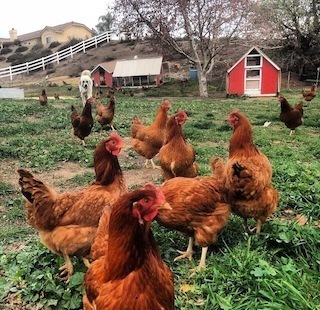 This is a guest post from Bethany McDaniel of Primal Pastures. Learn more about Bethany and Primal Pastures at the end of this article. Enter Bethany…
This is a guest post from Bethany McDaniel of Primal Pastures. Learn more about Bethany and Primal Pastures at the end of this article. Enter Bethany…
I still remember the first time I killed a chicken. I had watched it happen hundreds of times (my family runs a small pastured livestock farm in So-Cal called Primal Pastures). I’d even helped out with all of the other steps involved in chicken processing (scalding, plucking, eviscerating, and packaging), but I couldn’t quite bring myself to take a knife to a chicken’s throat and end its life.
But why?
I had no problem eating chickens that someone else killed. I’m not terribly freaked out by blood. And I had already gone through the gutting process more times than I could count (which is way gross-er than killing).
After about a year of helping out with processing days, I decided that it was time for me to kill a chicken.
So I finally did it — I cut into it’s throat so hard with a knife that the whole head fell right off. And much to my surprise, I suffered no emotional scarring, haunting chicken nightmares, or anything of the sort. It was merely another step in the process — a necessary part of producing food for my family and our customers to enjoy. And personally going through all of the steps involved in taking a chicken from pasture to plate in the most humane and safe way possible gave me a new sense of confidence and pride in my ability to provide food for myself — something I never knew I was capable of doing.
But not everyone sees it this way. I can’t tell you how many friends have asked me (with a horrified expression of disgust), “Wait – you actually kill the chickens?” As if this were some sort of barbaric act that any “normal” person would never take part in.
You can’t really blame them. Because of the horrific slaughter conditions of factory farmed animals, people often think that chicken processing is gross, mean, cruel, and inhumane. But in reality, animal slaughtering can be done in a way that is extremely quick and humane. And although it’s (sadly) not even close to being a common practice, it certainly is (and has always been) an extremely normal part of the circle of life.
This Used to Be Common Knowledge
In the early 1900s, chicken keeping was extremely common. Processing the birds was simply a part of life — and most people not only knew how to do it, but also processed chickens themselves on a regular basis. It was even normal for young children to help out with the chore under mom or grandma’s supervision.
But today, the thought of killing anything has become so taboo that many would rather believe their meat was grown in a plastic package at the grocery store than associate it with a once living, breathing animal.
Liz Wolfe sums it up beautifully in her book, Eat The Yolks:
Unfortunately, many of us are educated about animals by the entertainment industry. And through that lens, we acquire an image of nature that is wildly and tragically inaccurate. It’s an image with a rosy filter, one that ignores the fact that nature itself is, and always has been engaged in a cycle of life and death. A cycle that seems cruel and violent, rather than innate and natural when we’re raised on Disney instead of Discovery.
The outlook described above is convenient, but couldn’t be more distorted. And it’s left us lacking in our knowledge of meat and where it comes from — which is terribly unfortunate. Everyone has the right to learn and understand the work that goes into taking meat from its natural habitat to our plate. Without this understanding, we’re robbed of the appreciation and wisdom that comes from knowing how it all works.
Processing a Primal Chicken
After experiencing the life-changing effects of killing and processing chickens ourselves, we decided to start offering processing workshops to give others the opportunity to see and experience it for themselves as well. During these workshops, we provide participants with instruction and supervision as they go through all of the steps involved in taking a chicken from pasture to package, ready for the freezer or dinner table.
The workshops focus on the 5 stages of poultry processing: killing, scalding, plucking, eviscerating, and packaging. Each workshop guest has the opportunity to get hands-on experience with each station if so desired. They also have the option to slaughter their very own heritage breed, pasture-raised, soy-free, beyond organic meat bird, package it, and bring it home for their freezer.
We don’t require attendees to get hands-on with the processing and guests are always welcome to simply watch and learn. Either way, attendees end up walking away from the experience with a new outlook on food. Roberto (who attended our last workshop) said, “I grew-up hearing stories of my grandmother’s chickens and how she would make fresh chicken meals at a moment’s notice. After attending this workshop, I feel that I’ve matured in way that is analogous to a toddler learning to feed himself. This workshop helped me take another step towards becoming a fully matured meat consumer.”
His wife Dawn had a similar perspective. “I think everyone should be conscientious about where they get their food. People are afraid to know where their food comes from because of the horrors they hear about and see on television/the internet about factory farming. Taking the workshop from Primal Pastures gave me a sense of pride in being a meat eater.”
We realize that attending one of these workshops isn’t possible for everyone. But just knowing the process is a huge step in the right direction. So here it is – primal chicken processing in 5 steps (complete with photos from our most recent workshop):
Killing
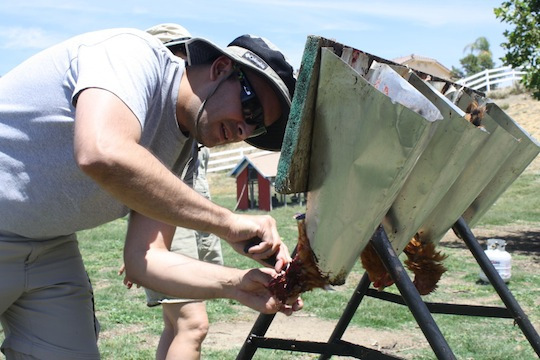
To start the killing process, birds are transferred from the pasture to a “kill cone” (pictured) and placed upside down, head out. Chickens enter into a natural trance state in this inverted position, which makes for excellent meat quality — the less stressed out an animal is prior to slaughter, the less adrenaline is released into the meat (adrenaline is what causes meat to become tough and chewy). Many CAFO (Concentrated Animal Feeding Operation) birds miss this step entirely and end up meeting their demise during the scalding step — a terribly inhumane way to die.
Scalding
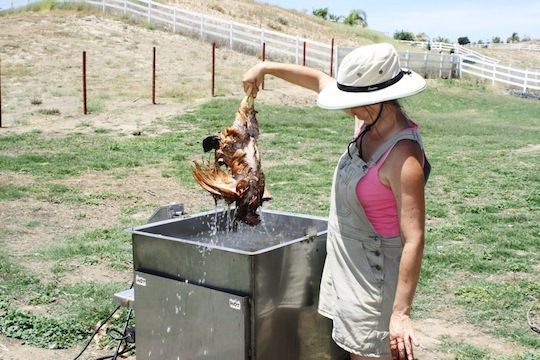
Birds are already dead before moving on to this step in the process. Scalding involves dipping the birds in hot water in order to loosen up the feathers. There’s a very fine temperature range that works in conjunction with the next step, plucking.
Plucking
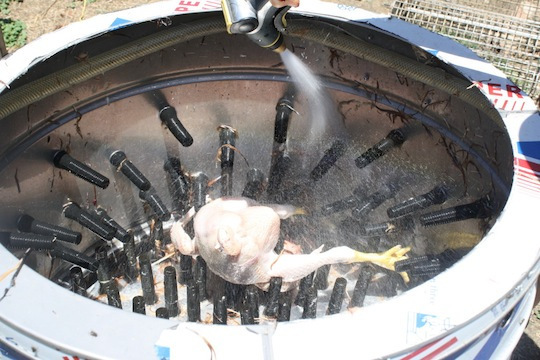
When the feathers are fully loosened up from scalding, the plucking machine takes them out for good. The chickens are spun around and sprayed with water to remove the feathers during this step. Many who see our plucking device de-feather four birds in 10 seconds are amazed, as this process would have taken your great-grandmother 5-10 minutes for just one bird. Want to see the contrast for yourself? Check out this video of hand plucking and this one of a plucking machine.
Eviscerating
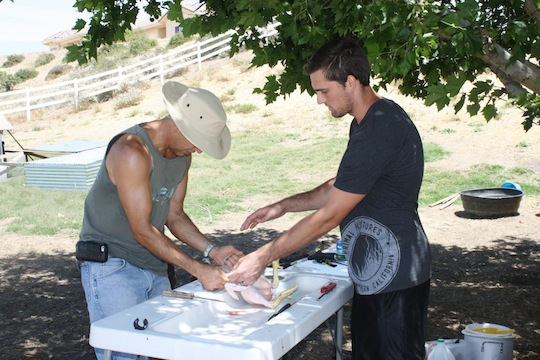
During the eviscerating step, we gut the birds and take out their insides. Almost every part of the chicken is saved and sold to customers. We sell the livers, hearts, gizzards, feet, and heads. Other parts (like the oil sack and intestines) are fed to our guard dogs. This is one part of the process that you just can’t learn without going through it a couple of times.
Packaging
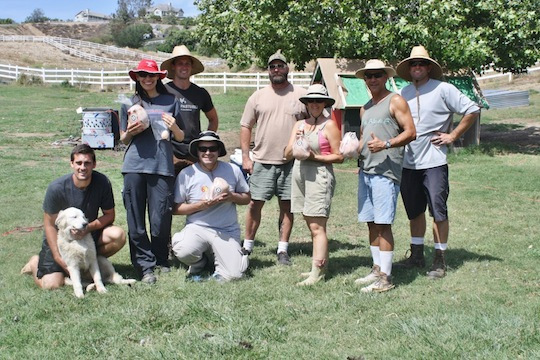
During this step, the whole carcass is placed inside of a bag, zip tied, and dunked into boiling water. Heat-shrink packaging gives the finished products a professional look and an air-tight seal that makes long-term freezing easy. The air leaves the package through a small hole which we cover up with a Primal Pastures sticker.
 We truly believe that if more people had the personal experience of processing at least one animal in their lifetime, it would change our entire country’s food system for the better. If you’re interested in joining us in Southern California for a processing workshop, farm tour, or potluck, check out all of these events on our website by clicking here. If you can’t get to Southern California, Eatwild.com has a great list of pastured livestock farms throughout the United States that may offer similar events.
We truly believe that if more people had the personal experience of processing at least one animal in their lifetime, it would change our entire country’s food system for the better. If you’re interested in joining us in Southern California for a processing workshop, farm tour, or potluck, check out all of these events on our website by clicking here. If you can’t get to Southern California, Eatwild.com has a great list of pastured livestock farms throughout the United States that may offer similar events.
This was a guest post from Bethany McDaniel of Primal Pastures — a small, beyond organic farm in Southern California that raises pastured chicken, lamb, turkey, and more. Bethany works on the farm with her family and runs the Primal Pastures blog, From the Pasture. Follow her blog or keep up with her on Instagram for useful and entertaining information about farm life, real food, wellness, and everything else that makes up her primal lifestyle.
Like This Blog Post? Dig Deeper with Primal Blueprint Books and Learn How You Can Reprogram Your Genes to Become Leaner, Stronger and Healthier




July 14, 2014
Dear Mark: Sun Exposure and Eyesight; Vasectomies
 For today’s edition of Dear Mark, we’ve got a quick two-parter. First, I discuss the pros and cons of ocular sunlight exposure in children (and adults). Should kids leave the house with a pair of wraparound goggles every single time, or are their prepubescent eyes safe without them? If too much sun exposure is bad, is none the best? Then, we cover the pros and cons of getting a vasectomy. Are there real health risks, like increased chances of cancer and/or heart disease? Will you lose functionality down there and experience a drop in testosterone?
For today’s edition of Dear Mark, we’ve got a quick two-parter. First, I discuss the pros and cons of ocular sunlight exposure in children (and adults). Should kids leave the house with a pair of wraparound goggles every single time, or are their prepubescent eyes safe without them? If too much sun exposure is bad, is none the best? Then, we cover the pros and cons of getting a vasectomy. Are there real health risks, like increased chances of cancer and/or heart disease? Will you lose functionality down there and experience a drop in testosterone?
Let’s go:
Dear Mark,
The linked WSJ article seems a tad overblown with respect to the risks the sun poses to kids eyes. Would love to get your take.
It’s very similar to the conventional wisdom on sun exposure for skin: less is better, all the way to zero. In my view, that simply can’t be optimal for humans.
I’ve got three girls. Should I be sending out into the world with sunglasses, always??
James
It depends.
While I’m definitely a fan of the sun and regular sun exposure, and I agree that the article is pretty alarmist, there are real issues with too much sun exposure to the eye:
Photokeratitis – Temporary inflammation of the cornea from excessive UV radiation. This is basically a corneal sunburn. Painful but reversible and doesn’t seem to cause any long term complications. Snow-farers know it as snow blindness because the highly reflective snow amplifies the UV. The Inuit even made snow goggles from caribou antlers, cutting slits that allowed just enough light to see without causing snow blindness.
Pterygium – Mostly cosmetic, a pterygium is a blemish along the conjunctiva (the thin layer lining the white of the eye) that can become irritated and inflamed. Evidence shows that UV exposure is a likely risk factor, with outdoor postal workers experiencing higher rates of the condition.
Cataract – The leading cause of blindness, cataracts form when proteins in the lens unravel, become entangled, and absorb pigment that then increasingly obscures the vision. Ocular UVB exposure is a risk factor for cataract formation, which is why French mountain guides – who are constantly outside during the day without much respite - have far more cataract formation and surgery than non-guides.
Overall I’m with you, James. Sunlight is a reality of the outside world and unavoidable if you’re outside; we are creatures of the outdoors. We’ve established that moderate amounts of sunlight are definitely good for our skin and our overall health, and it’s difficult to fathom that going outside for an hour or two without judiciously slapping a pair of Blue Blockers on immediately would place our eyesight in mortal danger. Too much? Sure, that’s true for most stimuli, let alone the light from a massive ball of cosmic energy illuminating. But a normal, sane amount? Given the ubiquity of sunlight in the natural environment and the fact that we’ve evolved in said environment, it seems implausible that any modicum of sunlight is dealing major damage to our eyes.
There may also be benefits to unfiltered ocular sun exposure. We often talk about the dangers of excessive light at night disrupting your sleep by inhibiting melatonin secretion. Well, the opposite happens when you get it during the day: it wakes you up and establishes (or maintains) a healthy, natural circadian rhythm. If you’re always avoiding full spectrum, truly bright daytime light, your rhythm will be off. And sure enough, people who get the most light during the morning and daytime begin producing melatonin earlier in the evening. There’s nothing better than full on sunlight to provide that.
Is there a time for sunglasses? Yes, just as a good UVA-and-UVB-blocking zinc oxide sunscreen can come in handy when you know you’re going to be out in the sun without shade for longer than you and your skin would prefer, a pair of sunglasses that block both UVA and UVB can help protect your eyes in the same situation. Doubly so if you’re in the snow, on a body of water, or at the beach where the power of UV is reflected and magnified; glasses are a good option to have in these situations. I wear ‘em myself – just not all the time.
I would provide sunglasses for your girls, not force them. As the pediatric opthomologist in the article even mentions, it’s better to run around and play outside without sunglasses than sit inside and watch TV. Besides, your kids are probably eating nutrient-dense, antioxidant-rich food, and that’s protective of the eye against sunlight damage. A smart, sane position is to get some sunlight directly in your eyes each day. Not a huge amount. Don’t stare into the sun on purpose or anything silly like that. Just go outside without sunglasses on (but handy in case you need them), go about your business, and the light will come to you.
Mark,
My wife and I are done having kids, but we’re also done with condoms and birth control. Neither of us can stand either, so I’m thinking hard about getting a vasectomy. Is there anything I should know? Are there any dangers associated with the procedure and the aftermath? I want everything else to work as intended, ya know?
Thanks,
Tim
Good news, Tim. The evidence strongly suggests that your facilities will remain fully operational, your sex life will improve (or at least stay the same), and your testosterone levels will be unaffected. All they’re doing is capping the vas deferens – the tubes that deliver sperm during ejaculation. You can still ejaculate, and the “body” is none the wiser. You’re just “inactive.”
In one 2005 study of 64 men about to undergo vasectomy surgery, researchers analyzed their sexual function pre-op and 90 days post-op. 67% of the men improved their function after surgery, while 17% worsened and 16% remained constant. Another study found that roughly a third of men enjoyed improved sexual function after vasectomy, while nearly 50% remained unchanged. The results differ across other studies, but for the most part the vast majority of men enjoy improved or unchanged sexual function after getting a vasectomy. If you’re happy with your work now, you’ll be fine.
Vasectomy seems to increase sexual satisfaction among couples as well. Husbands who received vasectomies and wives who received husbands who received vasectomies both reported improved sex, with the women enjoying the biggest increases in satisfaction. 93% of the males and 97% of the females would “recommend and do vasectomy again,” such were the benefits.
Rats who get the snip have similar testosterone profiles as intact rats. Although no human data exists, the fact that erection function and sexual satisfaction usually either increase or stay the same in post-op men indicates that testosterone is unaffected.
Associations between vasectomies and various health risks have been proposed, however.
Heart disease: There were very faint inklings of a connection between the two, but recent evidence has ruled it out.
Cancer: Much the same story as heart disease. Suspicion has made way for exoneration. Testicular cancer? No connection.
You might have seen the reports of a new study showing a link with prostate cancer. That’s true, and the headlines are scary. But consider that men who’ve had a vasectomy are probably more frequent visitors to the urologist than intact men. They’ll be receiving more tests in general and there will be more opportunities to take prostate cancer tests. Even still, the increase in absolute risk potentially caused by vasectomy remains low.
Sex with a loved partner is very important for many people. And on a physiological level, it’s extremely healthy. If this vasectomy will help you have more and better and less stress-free sex with your wife, it’s absolutely worth the very slight potential increase in prostate cancer risk. Go for it.
Thanks for reading, all. Let’s hear what you have to say about all this in the comments!
Not Sure What to Eat? Get the Primal Blueprint Meal Plan for Shopping Lists and Recipes Delivered Directly to Your Inbox Each Week




July 13, 2014
Weekend Link Love – Edition 304
 Paleo Girl author Leslie Klenke has a big giveaway going on, wherein you have a chance to win copies of Paleo Girl, Primal Fuel, gift certificates to PrimalBlueprint.com and a few other prize items. It ends on July 17. Check it out.
Paleo Girl author Leslie Klenke has a big giveaway going on, wherein you have a chance to win copies of Paleo Girl, Primal Fuel, gift certificates to PrimalBlueprint.com and a few other prize items. It ends on July 17. Check it out.
Research of the Week
Just a square or two of 75% dark chocolate a day was enough to improve vascular function in healthy individuals.
Almonds improve endurance exercise performance.
To animals with faster metabolisms, time appears to pass more slowly. Maybe that’s why my dog was really pushing to see the high-frame rate version of The Hobbit.
Interrupted sleep may be as bad for you as no sleep.
C-sections have epigenetic effects on babies’ DNA via an interesting pathway: hormesis. Though c-sections are less stressful for the fetus than vaginal births, early life stress is crucial for activating fetal defense mechanisms that prepare the baby for life outside the womb.
Interesting Blog Posts
Corn flakes may be certified gluten-free, but they still contain a creepy legacy of sexual repression and anti-masturbation indoctrination.
A conventional cardiologist takes a skeptical look at statins.
Is natural bodybuilding a form of (reversible) castration?
Media, Schmedia
I like Vice’s take on the prospect of calorie-counting appliances.
Everything Else
Don’t forget to register for the 2014 Ancestral Health Symposium, coming to Berkeley, CA this August 7-9. Unfortunately, I won’t be able to attend this year, but that shouldn’t stop you.
Take a dog to your next job interview.
It’s becoming pretty clear that pesticides are affecting bees. This time, it’s impairing their ability to forage (and thus pollinate).
Is the universe at risk of a vitamin D deficiency? (Probably not, but I couldn’t resist. Besides, everyone knows the universe supplements with D3.)
Recipe Corner
I bet you could serve this grilled beef heart with lemon and cracked pepper marinade without anyone freaking out.
Simple, elegant, perfect: prawn skewers and black mint pesto.
Time Capsule
One year ago (July 13 – July 19)
5 Chemicals in Cosmetics You Should Avoid – You might not want to be slathering your body in these ingredients, just to be safe.
Dear Mark: Food Combining – Is your tendency to eat a mango with your steak killing you? Find out!
Comment of the Week
Genetic testing of the so called yeti fur yielded nothing out of the ordinary…
OH WAIT. Except for the probable previously unknown himalayan bear species with at least some genetic input from a long-extinct set of polar bears. As in, a large predatory mammal species in a populated area that remains undescribed by modern science.
- Yup. It was still a pretty big deal.
Like This Blog Post? Dig Deeper with Primal Blueprint Books and Learn How You Can Reprogram Your Genes to Become Leaner, Stronger and Healthier




Weekend Link Love
 Paleo Girl author Leslie Klenke has a big giveaway going on, wherein you have a chance to win copies of Paleo Girl, Primal Fuel, gift certificates to PrimalBlueprint.com and a few other prize items. It ends on July 17. Check it out.
Paleo Girl author Leslie Klenke has a big giveaway going on, wherein you have a chance to win copies of Paleo Girl, Primal Fuel, gift certificates to PrimalBlueprint.com and a few other prize items. It ends on July 17. Check it out.
Research of the Week
Just a square or two of 75% dark chocolate a day was enough to improve vascular function in healthy individuals.
Almonds improve endurance exercise performance.
To animals with faster metabolisms, time appears to pass more slowly. Maybe that’s why my dog was really pushing to see the high-frame rate version of The Hobbit.
Interrupted sleep may be as bad for you as no sleep.
C-sections have epigenetic effects on babies’ DNA via an interesting pathway: hormesis. Though c-sections are less stressful for the fetus than vaginal births, early life stress is crucial for activating fetal defense mechanisms that prepare the baby for life outside the womb.
Interesting Blog Posts
Corn flakes may be certified gluten-free, but they still contain a creepy legacy of sexual repression and anti-masturbation indoctrination.
A conventional cardiologist takes a skeptical look at statins.
Is natural bodybuilding a form of (reversible) castration?
Media, Schmedia
I like Vice’s take on the prospect of calorie-counting appliances.
Everything Else
Don’t forget to register for the 2014 Ancestral Health Symposium, coming to Berkeley, CA this August 7-9. Unfortunately, I won’t be able to attend this year, but that shouldn’t stop you.
Take a dog to your next job interview.
It’s becoming pretty clear that pesticides are affecting bees. This time, it’s impairing their ability to forage (and thus pollinate).
Is the universe at risk of a vitamin D deficiency? (Probably not, but I couldn’t resist. Besides, everyone knows the universe supplements with D3.)
Recipe Corner
I bet you could serve this grilled beef heart with lemon and cracked pepper marinade without anyone freaking out.
Simple, elegant, perfect: prawn skewers and black mint pesto.
Time Capsule
One year ago (July 13 – July 19)
5 Chemicals in Cosmetics You Should Avoid – You might not want to be slathering your body in these ingredients, just to be safe.
Dear Mark: Food Combining – Is your tendency to eat a mango with your steak killing you? Find out!
Comment of the Week
Genetic testing of the so called yeti fur yielded nothing out of the ordinary…
OH WAIT. Except for the probable previously unknown himalayan bear species with at least some genetic input from a long-extinct set of polar bears. As in, a large predatory mammal species in a populated area that remains undescribed by modern science.
- Yup. It was still a pretty big deal.
Get the 7-Day Course on the Primal Blueprint Fundamentals for Lifelong Health Delivered to Your Inbox for FREE




July 12, 2014
Baked Eggs with Creamy Spinach
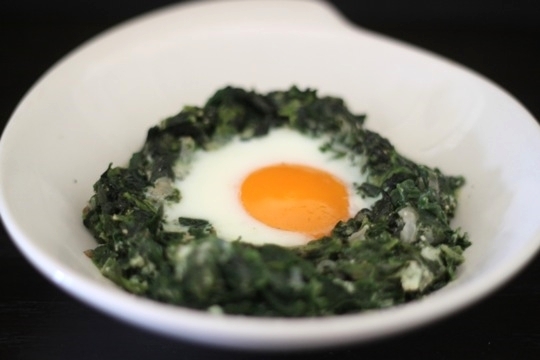 Get a head start on your daily intake of nutrient dense leafy greens by eating a serving first thing in the morning. Maybe salad isn’t exactly what you want to pair with your morning cup of coffee, but an omelet or frittata stuffed with greens is. Or, try a new recipe like baked eggs with creamy spinach.
Get a head start on your daily intake of nutrient dense leafy greens by eating a serving first thing in the morning. Maybe salad isn’t exactly what you want to pair with your morning cup of coffee, but an omelet or frittata stuffed with greens is. Or, try a new recipe like baked eggs with creamy spinach.
Besides the fact that it’s loaded with spinach and is an easy one-pan meal, another great thing about baked eggs with creamy spinach is that it tastes really good when made with frozen spinach. It’s not a bad idea to always keep a bag of frozen spinach in your freezer, and not just so you can make this recipe regularly. Also, because freezing food preserves the nutrient content, so frozen spinach is often more nutritious than the “fresh” spinach on grocery stores shelves.
What’s the easiest way to defrost frozen spinach and get all that moisture out? Put the spinach in a fine mesh strainer or colander with really small holes and run warm water over it until the ice is gone. Press down on the spinach with your hands to remove moisture then put the spinach in the middle of two paper towels (spinach won’t stick to paper towels). Fold the paper towels over the spinach, like a little square package, then squeeze until most of the moisture is gone. Voila – dry, defrosted spinach without any mess.
The creamy part of this recipe is coconut milk (although you could use whole cream). Mushroom powder is whisked into the coconut milk, both to give the dish savory flavor and to thicken the coconut milk a bit. Mushroom powder is dried mushrooms of your choice, ground in the coffee grinder until fine. This homemade, savory powder can be added to just about any sauce to thicken it slightly and add mushroomy flavor.
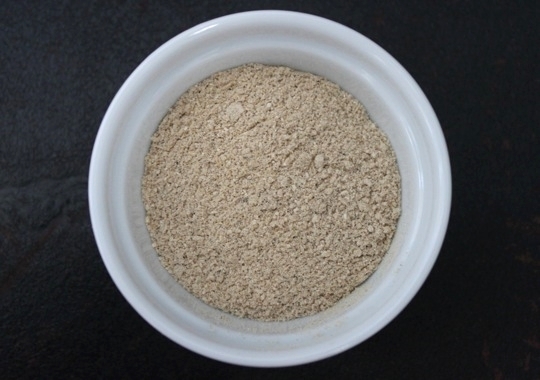
Servings: 4
Time in the Kitchen: 30 minutes
Ingredients:
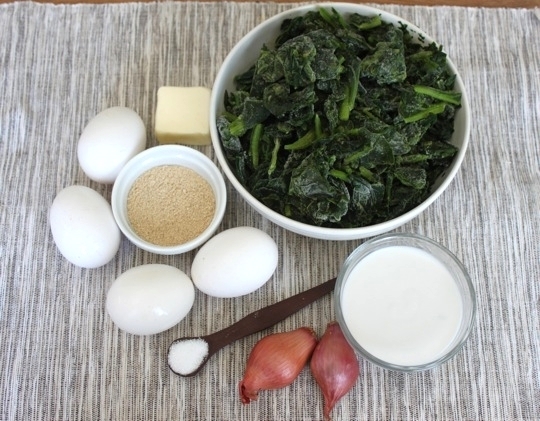
20 ounces frozen chopped spinach (567 grams)
2 tablespoons unsalted butter (30 ml)
2 shallots, finely chopped
2 tablespoons dried mushroom powder (see explanation above) (30 ml)
1 cup coconut milk (240 ml)
1/2 teaspoon kosher salt (2.5 ml)
4 eggs
Instructions:
Preheat oven to 450 °F/232 °C.
Put frozen spinach in a fine mesh strainer or a colander with very small holes and rinse under warm water to defrost. Use your hands to push/squeeze out moisture. Put half of the spinach into the middle of two paper towels and fold the paper towels over the spinach to form a square package. Squeeze out as much liquid as possible. Dry the rest of the spinach the same way. Set the spinach aside. In a skillet, melt the butter over medium-low heat. Cook the shallot until soft, 2 minutes.
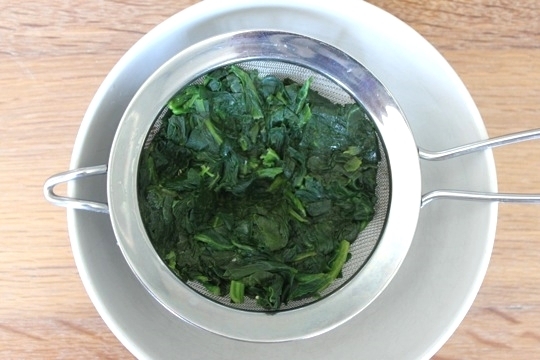
In a skillet, melt the butter over medium-low heat. Cook the shallot until soft, 2 minutes.
Whisk the mushroom powder and salt into the coconut milk. Pour into the skillet. Add the spinach. Cook for a minute or so, until the spinach absorbs most of the coconut milk.
Scrape spinach into an 8×8 pan (20 cm x 20 cm) or smaller pan, or a small, ovenproof skillet.
Use a spoon to make 4 deep wells that an egg can be dropped into. Crack an egg into each well and bake 7 to 10 minutes, until the whites are set but yokes are still soft.
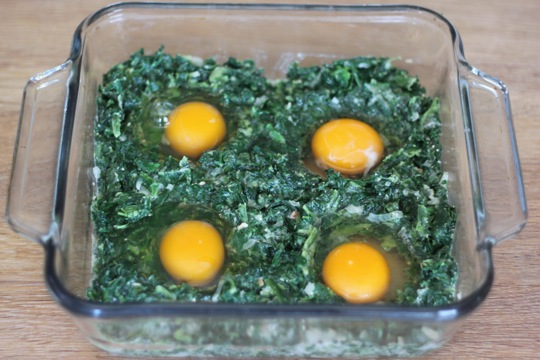
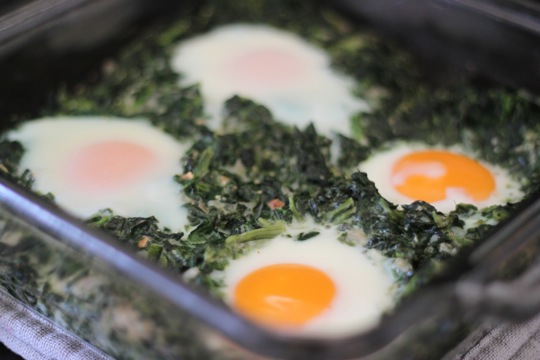

Not Sure What to Eat? Get the Primal Blueprint Meal Plan for Shopping Lists and Recipes Delivered Directly to Your Inbox Each Week




July 11, 2014
What a Difference 110 Pounds Makes
It’s Friday, everyone! And that means another Primal Blueprint Real Life Story from a Mark’s Daily Apple reader. If you have your own success story and would like to share it with me and the Mark’s Daily Apple community please contact me here. I’ll continue to publish these each Friday as long as they keep coming in. Thank you for reading!
 All of my life I’ve been a social creature. I could adapt to almost any environment that I was placed in. I joined the US Navy at age 27, and went to language school in Monterey, California, nearly a decade older than most of my peers. But, I adapted, developed an amazing group of friends, and learned a foreign language.
All of my life I’ve been a social creature. I could adapt to almost any environment that I was placed in. I joined the US Navy at age 27, and went to language school in Monterey, California, nearly a decade older than most of my peers. But, I adapted, developed an amazing group of friends, and learned a foreign language.
I was stationed in Seoul, South Korea, and even there I was able to find a niche and thrive. Granted, I was with the military (where there is always a sense of community) but it was not within that community that I found my footing. It was with a group of ex-pats who all played soccer. We were a family, albeit dysfunctional, and we always had each other’s backs.
About six months after moving to Seoul, I broke my ankle, and put on some weight. One of my teammates and I decided to do Body for Life together. During this 12 week program, I lost over 40 pounds and was in the best shape of my life. I learned then, that my body was capable of doing great things.

I have never been the “skinny” girl – but I was definitely fit! This was 2003.
As with any “diet,” it did not last. A broken heart, a move back to the states, and an uncertain future all contributed to my gaining weight. I was able to stay within standards of the military, but after a few deployments to Afghanistan, and the decision to move on from the military, I really started to gain weight.
In 2008, honorably discharged from a nearly 10-year stint in the Navy, I decided I needed another change in environment, and found myself in Huntsville, Alabama. I had no friends, no family, nothing here, but it just seemed to be a good place for me to go. The cost of living was low, and I had a great opportunity with my company. It took about six months for me to realize that my ability to socially integrate anywhere was not working here. And I sunk into a depression.
There were so many factors at play. I had just moved. I had just ended a 10-year fast paced work life (where you are essentially issued friends and a network). My future was uncertain, and then I suffered a compound fracture of my wrist. When I started taking anti-depressants, I really started to put on the weight. When I first started seeing my therapist in 2009, I weighed around 280 pounds, and at the end of 2012, I weighed 314 pounds.
I told my psychiatrist that I wanted to stop taking the meds, and he didn’t disagree with this, but I am pretty certain he was a little worried. I don’t think that the medications were hurting, but I also don’t think they were helping. I was numb, I felt nothing, and my desire for change and a healthy life were not forthcoming.
So, I decided to sell my house, as I realized that living alone at that time was not a prudent choice for me. I rented a small in-law apartment from a co-worker, and decided to look into bariatric surgery. My insurance fully covered it if I met certain requirements, one of which was a recorded BMI over 40 for at least one-year. Check! I had to meet with a nutritionist once a month for six consecutive months. Check! I had to consult with a general physician and attempt weight loss. Check! Then a date would be set, and I opted for the sleeve, which is removing 80% of your stomach.
I had to spend a month on the road for work, and when I got back to Alabama, the first thing I did was call the nutritionist and start the process. In April 2013 I received an email from a friend with details about The Biggest Loser Casting Call. I decided why not…
I had started to make tiny changes in my diet. Nothing drastic, but adding a protein shake once a week instead of a trip to McDonald’s. And I started to make tiny changes to my habits, again nothing drastic, but I parked at the absolute furthest spot from my office building forcing me to walk an additional 40 yards to and from my car.
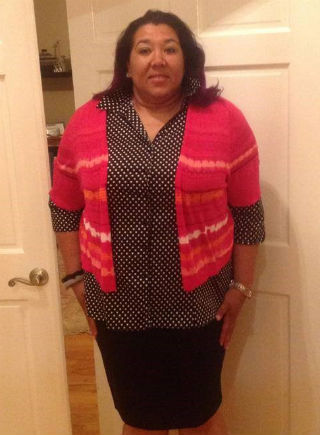 This was one of the outfits I considered for the auditions – it was summarily vetoed on account of the tie-dye and polka dot combination. I realize now, looking back – I intentionally would dress like this to draw attention away from the weight. People would notice the outrageous clothing combinations, and comment before they could say anything about my size. Of course, now, I have zero clothes that fit, and no sense of style or how to wear clothes for my new body – I am trying a different avenues to remedy this, but ultimately need a total makeover!
This was one of the outfits I considered for the auditions – it was summarily vetoed on account of the tie-dye and polka dot combination. I realize now, looking back – I intentionally would dress like this to draw attention away from the weight. People would notice the outrageous clothing combinations, and comment before they could say anything about my size. Of course, now, I have zero clothes that fit, and no sense of style or how to wear clothes for my new body – I am trying a different avenues to remedy this, but ultimately need a total makeover!
I got to the auditions after careful consideration of my outfit, and sat down, and was asked, “Why Biggest Loser?” I honestly had not thought about it until that very moment. Sure, I want to be on TV, sure I wanted the benefit of the trainers, nutritionists, medical staff, sure, I want to do nothing but focus on my weight loss for however long I lasted on the show… but really, “Why?” I stated the following: I am motivated, I am ready for this. I miss the freedoms of not carrying over 300 pounds. I miss being able to play soccer without fear of getting hurt. I want the accountability. I want America to watch me and say, “You will not fail today!” I want 25 million people to stand behind me and tell me that I can do this, because I am not sure if I can.
I walked out, and my friend asked me how I did. I said, “I don’t think I was traumatic enough…” and sure enough, I didn’t get a call back.
In all honesty, I was not that confident that I was motivated and ready. It just seemed like the right thing to say. I was scared. I was nearing another birthday and I didn’t want it to be another birthday with a dim outlook for my future. I was fortunate in that I was a “healthy fat person.” I didn’t have blood pressure issues that warranted weight loss and I didn’t suffer diabetes or any other obesity related ailments. I was just overweight—overweight and more self-conscious than ever. Overweight and alone. Overweight and lived for eating fast food, sugar and grains; my favorite was the McGriddle, which combined all three.
I went home and started to put together a video for submission, but my dog was acting pretty needy, and work was busy, and there were just a lot of excuses. So, I didn’t make the video. But I thought a lot about my response. After my initial post about going to the auditions, two friends from high school approached me about Isagenix. I was willing to try anything. There was a lot of outward concern also about my desire to have surgery.
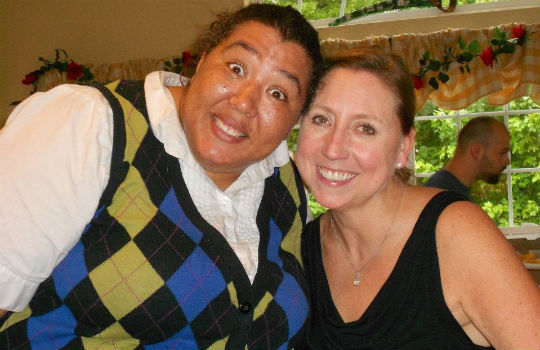
Every picture I took I would make faces – again – to mock the size – to beat people to the punch – there was never “Gee Felicia, you have really let yourself go” because it was always “Gee Felicia do you ever just take a normal picture?”
When I was in the military, there was a family that adopted me on holidays. We clicked so well, that it continued on through the years, and I genuinely love them. There were two sides of the argument there. Husband: If she was dying of heart disease and open heart surgery could help, would you argue against it? Wife: I just think that she could lose weight without invasive surgery. Both are right. But, just “losing weight” is a daunting task. And for someone who is independent, with nothing but a dog by her side, there was no one that I thought would be able to hold me to my goals. I knew I couldn’t do it alone. So I went back to thinking about my response to The Biggest Loser.
Accountability… So, I may not have America, but I have 500 people on Facebook that in some way, shape, or form over the course of my life have had an influence, and they can still…
So, I reached out on FB – I decided that I would be shameless, fearless, and put it all out there. It is not like I could “hide” the fact that I weighed over 300 pounds. Right? It is not like I didn’t know I was ‘fat,’ even though most people in my life were all very kind, there was no denying that I could stand to lose a few pounds.
I posted this:
“Friends…I have decided that my dream of Biggest Loser is officially over – However, the goal was not to be on the show, but it was to be able to be in a situation with a personal trainer, no distractions and only gym for 10 hours a day, a nutritionist to help make meals, and the support and accountability to all of America. So, since that dream is dead…here is my new plan – I am still planning on going through the motions toward surgery – I am still watching what I eat and starting to exercise little by little – Amy and Kymberly are talking to me about Isagenix (still waiting to see how the shakes are), and I am going to start a blog. I will be calling it “From Fat to Fab!” And my goal is by my 43rd birthday (July 1, 2014) I will weigh at least 100 pounds less than I do today – to be healthy and be working toward running in a marathon – stay tuned for details of the blog! And please help me – if you see me doing something I shouldn’t or need a little motivation – just a subtle nudge here and there.”
I started the blog the same day (fleepyear.com).
What happened next was nothing short of amazing…
The outpouring of support and help that I received flooded me with emotion and drive. My former teammate that I did Body for Life with posted:
“I’ve seen u do it before. So you know it’s not impossible. Let me know if I can help. I’m happy to be support on your accountability team.”
And so many more comments that pushed me in the right direction.
Two weeks after I posted my Facebook status, I posted that I was going to start shopping for a gym. A girl I played soccer with over a decade ago sent me a private message encouraging me to try CrossFit.
I googled it.
I laughed.
I wrote back, “Thanks, but not so much.”
She pressed.
I considered the fact that I had been willing to dump over $500 into Isagenix without blinking an eye, and that I might as well go and talk to these people.
I was desperate. Someone could have approached me and said, “Listen, if you chant every morning while wearing polka dots and flowers, you will lose weight.” I would have done just that.
I walked into the CrossFit box and felt terrified. But, after a few minutes, I felt that this was just what I needed, and the attitude of the head coach was unbelievable. He was positive without setting me up for failure. He was realistic and explained what I needed to do to be successful. And that was listen to the coaches, listen to my body, and not be in a hurry…
So, I signed up for CrossFit.
Before I go into the next chapter, I need to make mention of a few milestones that occurred along the way. There were these small little occurrences of friendship through my time in Alabama that for whatever reason, mostly because of my own insecurities, I never put much stock into them. I assumed that these people were being friendly for the sake of professionalism and kindness, but not that I had anything to really offer them. One of these friendships is a man named Wes. Wes was that guy in the office that is Chris Traeger (ref: Parks and Rec). We worked on a project together, and once day he came in to my office looking for me and found nothing but a half eaten Egg McMuffin. He snapped a picture and that was the image that showed up whenever I texted or called. When I say he was Chris Traeger, I mean he would come into my office and mid conversation would just start doing squats. Most of the time I felt an overwhelming urge to punch him, but he came from a place of good. I was in charge of diversity and inclusion in my office, and he approached me wanting to get more involved. I teamed him up with another of these “friends” to do a Biggest Loser sort of challenge within the office.
The competitive side of me forced me to talk to Wes about my diet. He mentioned paleo then, and I giggled, and it was another “friend” that suggested that Atkins would be more my style, since I had zero desire to do any sort of activity beyond switching the channels on the TV. All was going well, until I ended up spending a month in Colorado Springs living out of a hotel. I had lost about 20 pounds, but it quickly came back when I would eat anything and everything I could and sit at my desk for 15 hours straight.
Then I met Jon, who was crazy, and did this thing called CrossFit and ate “Paleo.” He was not very strict, but tried to stick to the principles of it. I worked with Jon on another project immediately following the one in Colorado, where I learned a little more about his lifestyle. I still thought he was crazy.
So, here I was, about a month into my “journey” (I really hate that word), with no real direction, failed at Isagenix, and was just starting at CrossFit. I was not really following any sort of diet or meal plan. I was watching what I was eating, but still eating grains, sugar, legumes, and dairy.
The girl that told me to start CF is a coach at a box in Lexington, KY, and quite accomplished I might add. When I played soccer with her, she was a doe-eyed, sweet 17 year old, hanging toe to toe with a group of dirty old has-beens, never was, and social alcoholics. We were not a soccer club; we were a drinking club with a soccer problem.
Kelli had gone on, went to college, gotten her masters in nutrition, and was now coaching full time at CrossFit. Another friend of mine from my military days had just started coaching, and her and her husband had just opened a box.
I started a conversation with the two of them on Facebook, and on a daily basis went to my “secret” coaches for tips, tricks, and advice.
At first it was all about CrossFit.
Then, I had heard enough about paleo that I decided to start to research it. This was a week prior to my 42nd birthday. I had mentioned it in passing to a couple of people, and on my birthday, was given three paleo cookbooks.
After receiving the paleo cookbook gifts, I did more digging. I was led to Mark’s Daily Apple, Paleohacks, and Nom Nom Paleo – and I was off and running. On a daily basis I was consulting these websites and my secret coaches and now nutritionist on Facebook.
I was focused, determined, and positively neurotic.
And it happened… magic… over the course of the year, I literally shed over 100 pounds, gained strength, and so much more.
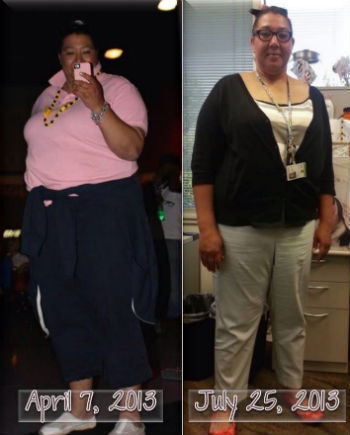
I could tell you all about my blood pressure and cholesterol and scale and inches, but the two most important things I gained were my confidence and friendships. I don’t hide in pictures anymore. I don’t only post pictures of my dog on FB, although I do shamelessly post pictures of my food.
I once loved to cook for people and for myself. But over the course of the weight gain period, this became too labor intensive and too depressing. Now, with my new lifestyle, I have no problem spending eight hours in the kitchen laboring over Mexican beef or Kahlua pork. I love discovering new recipes and tweaking them to my palette.
And what I also love about this is how easy it has become to sustain. I can count on both hands the number of “cheat” meals I have had over the past year. There is no shortage of information, knowledge, and people willing and able to share.
Make no mistake about it; the magic was the result of hard work and putting in time in the kitchen and gym. I tell people now, it is not just calories in and calories out, and it is what kind of calories in and what kind of calories out. Is CrossFit high-risk? Sure, but so is driving, and so is sitting for prolonged periods of time, and so is breathing in some parts of the world. I never stopped listening to my coaches, and the more I did it, the more in touch I got with my body. I knew when a pain was more than just, “Hey, you are sore…” but I also learned through research that there were foods that I could eat post workout that would lessen the soreness and pain.
On days when I would lift heavy, I would add a sweet potato or plantain. On days when it was more cardio intensive, I could add more fruit. I bought a pig from a local farmer, and truly looked at everything that I did as an investment in myself. I was worth it.
Needless to say, the surgery never happened… in July, literally two weeks after the decision was made by the birthday gods for me to be paleo, I was no longer eligible by BMI standards. I had lost too much weight.
For me, after about six months of consciously thinking about everything that I did as, “This is a choice that I have to make,” it became second nature.
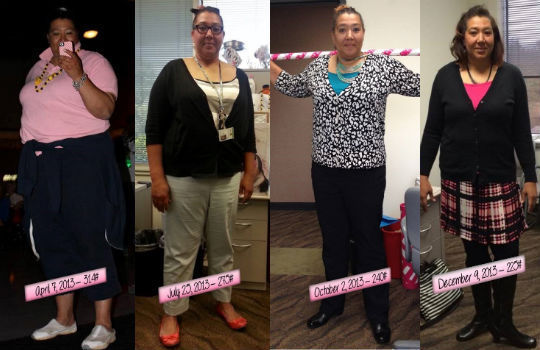
My views on cheat meals… well, I looked at paleo like a husband. It is not like after you get married you say to your spouse, “Okay, it has been three months, time for a cheat!” You make a commitment, to yourself, your body, and to your will power. I will “cheat” when there is no option, a work function, or I don’t want to be “that person” who is super difficult to invite places. It is not hard to stay on course, but there are times when I have admittedly taken the easy route and just eaten the pizza – guilt free – worry free – and happily. I do make painstaking efforts to always be prepared, but no one is perfect… Right?
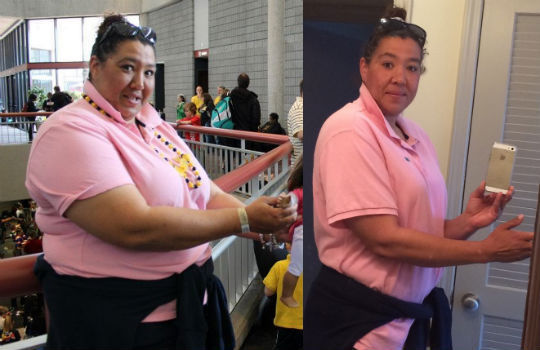
One year to the date – same shirt, same hoodie, same glasses.
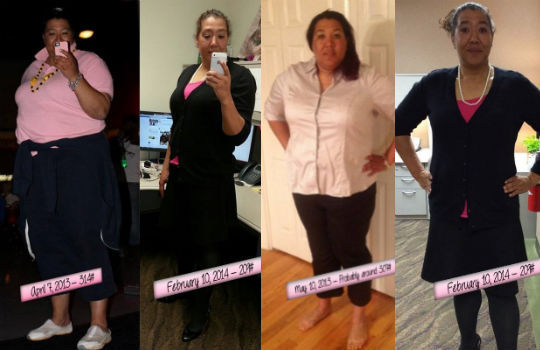
I am not stopping, it is not like I hit the year mark and said, “Okay, goal achieved, time to hit the ice cream truck!” Instead, I look back at my year and think, how can I help others achieve this?
So, the running joke with a friend is “body by bacon” – she told me at some point that I could not sustain weight loss and eat bacon every day of my life. I begged to differ. So, there has been some nights where it is well past my bedtime, and I realize, “I have not had my daily Vitamin Bcn,” and will throw a few slices on the stove and enjoy… and then tell my friend, “Do your research… fat doesn’t make you fat!”
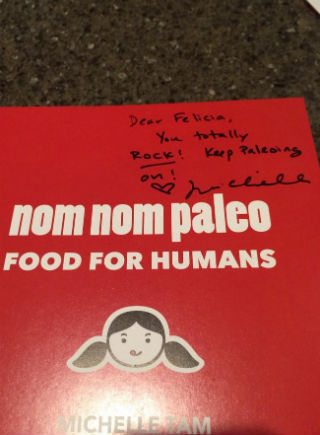
I stalked this poor woman – asking for help on recipes, and telling her repeatedly that it was her food that inspired me to get back in the kitchen and start taking this nutrition thing seriously! In order to get this, I sent a pregnant mom of a toddler and busy career woman the book and forced her to go to a book signing in her neighborhood. No, that would not be inconvenient… Michelle needs to make a trip to Huntsville!
Whenever I start to doubt myself, wonder where the magic is, think it is not happening fast enough, I look at the pictures of a year ago, and realize that with determination, discipline, bravery, courage, willpower, and above all, friends… you can do anything! My advice to the world… believe that you are worth it; the investment in yourself is not just about the money spent, it is the time put in. The information is there, and it takes trial and error to find the right combination for “magic.” It is okay to stumble, and even fall down; I have been known in some WODs to fall down hundreds of times, (it is called a burpee), but you get back up.
I have had a few friends reach out to me over the year to ask me what my secret is, and for help. And it usually brings a tear to my eye. I never set out to be inspiring. When one of my colleagues at work called me and said, “Thanks to you, I have lost over 50 pounds,” I was overwhelmed. I may have provided the proof that it can work, but I didn’t tell my colleague what to eat and how. I didn’t tell the girl I once coached soccer with, who has grown up and had babies, specifically what to eat—I pointed her in the direction of the same websites that I went to, and offered an ear whenever she needed. I didn’t tell the girl that I did CrossFit with to show up on a consistent basis and eat clean, but I did tell her that she was transforming before my eyes, just as I was to her. There are sources of inspiration all around; it is just a matter of choosing to see them.
In April of 2013, I weighed 314 pounds. I was wearing a size 24 pant, and a 26/28 top. I only shopped at Lane Bryant or online plus sized stores. I was far from confident and happy… Today, I weighed in at 210, and I own three pairs of pants that are size 12 and one shirt with a collar that fits!
But more amazing, (yeah, I went there) is the fact that I have lost a total of 88.5”. That is 7’ 4.5”. To put this in perspective, Yao Ming is 7’ 6” (Shaquille O’Neal is only 7’ 1″). I have nearly lost Yao Mong, a 2 month old horse, and an ostrich egg. But what I have gained…
Felicia
Get the 7-Day Course on the Primal Blueprint Fundamentals for Lifelong Health Delivered to Your Inbox for FREE




July 10, 2014
Baked Eggs with Creamy Spinach
 Get a head start on your daily intake of nutrient dense leafy greens by eating a serving first thing in the morning. Maybe salad isn’t exactly what you want to pair with your morning cup of coffee, but an omelet or frittata stuffed with greens is. Or, try a new recipe like baked eggs with creamy spinach.
Get a head start on your daily intake of nutrient dense leafy greens by eating a serving first thing in the morning. Maybe salad isn’t exactly what you want to pair with your morning cup of coffee, but an omelet or frittata stuffed with greens is. Or, try a new recipe like baked eggs with creamy spinach.
Besides the fact that it’s loaded with spinach and is an easy one-pan meal, another great thing about baked eggs with creamy spinach is that it tastes really good when made with frozen spinach. It’s not a bad idea to always keep a bag of frozen spinach in your freezer, and not just so you can make this recipe regularly. Also, because freezing food preserves the nutrient content, so frozen spinach is often more nutritious than the “fresh” spinach on grocery stores shelves.
What’s the easiest way to defrost frozen spinach and get all that moisture out? Put the spinach in a fine mesh strainer or colander with really small holes and run warm water over it until the ice is gone. Press down on the spinach with your hands to remove moisture then put the spinach in the middle of two paper towels (spinach won’t stick to paper towels). Fold the paper towels over the spinach, like a little square package, then squeeze until most of the moisture is gone. Voila – dry, defrosted spinach without any mess.
The creamy part of this recipe is coconut milk (although you could use whole cream). Mushroom powder is whisked into the coconut milk, both to give the dish savory flavor and to thicken the coconut milk a bit. Mushroom powder is dried mushrooms of your choice, ground in the coffee grinder until fine. This homemade, savory powder can be added to just about any sauce to thicken it slightly and add mushroomy flavor.

Servings: 4
Time in the Kitchen: 30 minutes
Ingredients:

20 ounces frozen chopped spinach (567 grams)
2 tablespoons unsalted butter (30 ml)
2 shallots, finely chopped
2 tablespoons dried mushroom powder (see explanation above) (30 ml)
1 cup coconut milk (240 ml)
1/2 teaspoon kosher salt (2.5 ml)
4 eggs
Instructions:
Preheat oven to 450 °F/232 °C
Put frozen spinach in a fine mesh strainer or a colander with very small holes and rinse under warm water to defrost. Use your hands to push/squeeze out moisture. Put half of the spinach into the middle of two paper towels and fold the paper towels over the spinach to form a square package. Squeeze out as much liquid as possible. Dry the rest of the spinach the same way. Set the spinach aside. In a skillet, melt the butter over medium-low heat. Cook the shallot until soft, 2 minutes.

In a skillet, melt the butter over medium-low heat. Cook the shallot until soft, 2 minutes.
Whisk the mushroom powder and salt into the coconut milk. Pour into the skillet. Add the spinach. Cook for a minute or so, until the spinach absorbs most of the coconut milk.
Scrape spinach into an 8×8 pan (20 cm x 20 cm) or smaller pan, or a small, ovenproof skillet.
Use a spoon to make 4 deep wells that an egg can be dropped into. Crack an egg into each well and bake 7 to 10 minutes, until the whites are set but yokes are still soft.



Not Sure What to Eat? Get the Primal Blueprint Meal Plan for Shopping Lists and Recipes Delivered Directly to Your Inbox Each Week




How Much Are You Willing to Pay for Your Health?
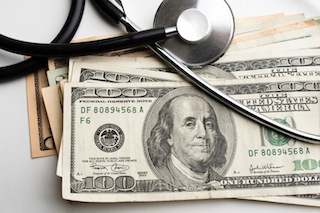 It’s a common refrain that living healthily costs an arm and a leg. The food bills, in particular, garner the biggest sighs and frustration: the price of pastured meats, eggs (and dairy for those who partake), of wild-caught fish, of organic this and that, of healthier nuts and nut butters, of just about any whole food. For some folks that doesn’t take into account the extra travel schlepping from place to place. Shopping for healthy food can be a long-range foraging expedition in some parts. Internet suppliers can help, but they don’t cover all the bases. The time, expense, and inconvenience of healthy food shopping (and preparation) add up, and some days we can wonder if it’s worth all the trouble. What if we just gave in? Gave up? What if we went back to buying the typical processed food products that seem to colonize nine-tenths of the country? Just think of the convenience – and the savings? Seriously, what would we do with all that money? For a while, it might seem like a financial boon. Over time, however, I think we’d be looking at another story.
It’s a common refrain that living healthily costs an arm and a leg. The food bills, in particular, garner the biggest sighs and frustration: the price of pastured meats, eggs (and dairy for those who partake), of wild-caught fish, of organic this and that, of healthier nuts and nut butters, of just about any whole food. For some folks that doesn’t take into account the extra travel schlepping from place to place. Shopping for healthy food can be a long-range foraging expedition in some parts. Internet suppliers can help, but they don’t cover all the bases. The time, expense, and inconvenience of healthy food shopping (and preparation) add up, and some days we can wonder if it’s worth all the trouble. What if we just gave in? Gave up? What if we went back to buying the typical processed food products that seem to colonize nine-tenths of the country? Just think of the convenience – and the savings? Seriously, what would we do with all that money? For a while, it might seem like a financial boon. Over time, however, I think we’d be looking at another story.
Last week’s post about prevention got me thinking about the comparative costs of living healthily versus not. After all, we supposedly love a good deal in this country. We’re coupon clippers, discount store shoppers, bargain hunters. Are we really getting the good deal we think we are when we cut the quality of our food substantially? Some people, I understand, are in tougher straits than others and are feeding families on a few dollars (or less) a day with no other choice. For those of us without such dire constraints, it’s illuminating to look at the real cost of ill health. We know the choices that feed disease. We can all use a good reminder that the money we put toward a healthy lifestyle is wisely invested.
Simply compare the cost of disease. People with diabetes, for example, pay medical costs 2.3 times higher than those without diabetes. Out of pocket spending for medications jumped from 23% to 47% between 1996 and 2007. Add to this multiple co-pays for not just primary physicians but assorted specialists (e.g. ophthalmologists, nephrologists, endocrinologists) who often monitor diabetes-related concerns. People without insurance or with high deductibles can spend thousands of dollars on equipment, including the cost of a pump and testing strips. The CDC and Research Triangle International in their simulated model to assess what an individual would pay out over the course of a lifetime for diabetes and related complications expenses pinned the average number at around $85,000. For men diagnosed between the ages of 25-44, lifetime direct expenditures were estimated at $124,700 and for women in the same age range at $130,800.
For cancer, the costs can be financially devastating to individuals and families. Duke University research calculates the average out of pocket cancer expenses at $712 a month, which adds up to more than $8500 a year. For prostate cancer specifically, ongoing costs in a 5-year period have been estimated at over $42,500. For breast cancer, costs have been estimated at $16,910 for those younger than 65 (PDF) and $23,078 for those over 65.
For cardiovascular disease, the numbers vary considerably based on intervention, but they’re all sobering. Cardiac pacemaker insertion is calculated at $33,000. The average heart valve procedure with hospitalization is estimated at $49,000. A “severe” heart attack overall can cost a million dollars in direct and indirect costs when lost work time, follow up visits and rehabilitation are considered. Clearly, in every case, we’re looking at big numbers – startling numbers – even when you figure in insurance coverage (which varies considerably).
A few years ago I held a poll asking what readers spent per person, per month on Primal food (including all shopping sources – e.g. grocery stores, meat shares, CSAs). The results varied, but nearly 70% reported that they spend $200 or more per person per month. How do those numbers settle for you in comparison to the “big ticket” diseases above? We all have to pay for food: that’s a given. Do we deem the extra amount (whatever we believe that is) we pay for good, whole, “clean,” nutrient dense food worth the investment? Do we accept that eating well (and making other healthy Primal choices) lowers our risk so considerably with regard to disease and related disability? Do we accept the bigger food bills as a continual long-term investment in health and vitality? Do we appreciate what we will in all likelihood avoid paying (literally and figuratively) when we make that investment?
I know for me the first thing that comes to mind is what it’s worth to feel good day to day. What am I willing to pay to feel good right now – to enjoy a full day’s worth of consistent energy, to feel I can take up any activity I want at any given moment, to get a good night’s sleep, to not be plagued by any of the aches, pains and other issues I used to experience before going Primal? How valuable is it to me to be healthy and vital enough to enjoy my family, to enjoy my years in whatever way I want? What dollar amount would I affix to being able to heli-ski at age 60 instead of shift into low gear? In our own ways, we each ask ourselves these kinds of questions. What is your answer today?
Thanks for reading, everyone. Offer up your thoughts on investing in a Primal life, and have a great end to the week, everyone.
Get the 7-Day Course on the Primal Blueprint Fundamentals for Lifelong Health Delivered to Your Inbox for FREE




July 9, 2014
Is the Obesity Epidemic Exaggerated?
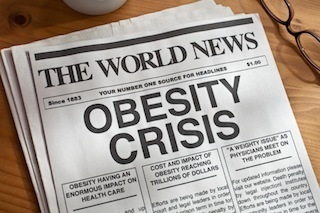 Obesity has reached epidemic proportions. People are fat and getting fatter, with no end in sight. Even kids are fat these days. Right? We’ve all seen the picture of the McDonald’s-eating toddler and heard the dire nightly news reports about growing obesity narrating back shots of anonymous overweight families trudging along with wedgies and short shorts. But just as the public at large bemoans the pervasiveness of the obesity epidemic, many critics are claiming the opposite: that the obesity epidemic is exaggerated and overinflated; that the “overweight” and “obese” categories are ploys by insurance companies to get more money from policy holders; that obesity in and of itself isn’t actually a health hazard. Some, like Paul Campos, are even arguing that America’s weight problem is “imaginary.”
Obesity has reached epidemic proportions. People are fat and getting fatter, with no end in sight. Even kids are fat these days. Right? We’ve all seen the picture of the McDonald’s-eating toddler and heard the dire nightly news reports about growing obesity narrating back shots of anonymous overweight families trudging along with wedgies and short shorts. But just as the public at large bemoans the pervasiveness of the obesity epidemic, many critics are claiming the opposite: that the obesity epidemic is exaggerated and overinflated; that the “overweight” and “obese” categories are ploys by insurance companies to get more money from policy holders; that obesity in and of itself isn’t actually a health hazard. Some, like Paul Campos, are even arguing that America’s weight problem is “imaginary.”
Could this be? Am I tilting at windmills when I decry our collective weight problem?
Let’s look at the claims being made.
First, there’s the claim that the definition of obesity is arbitrary and the obesity epidemic only arose because our definition of obesity changed to include more people. According to this argument, people aren’t necessarily any heavier, but what was previously assumed to be a healthy weight has now been deemed an unhealthy weight by statistical trickery. In his 2005 book, Fat Politics, J. Eric Oliver (PDF) tells the story of Louis Dublin, a statistician for MetLife insurance in the 1940s who analyzed the connection between age, bodyweight, and death rate among MetLife subscribers. Dublin found that thinner people generally lived longer and those who maintained close to the bodyweight of an average 25 year-old lived the longest. He published a new weight chart that shifted the healthy weight threshold back, effectively making millions of Americans obese or overweight overnight. And even though he did this to predict who would die earliest and determine who should pay the most for insurance policies, not to uncover a public health threat, it caught on and formed the basis for government policy regarding obesity and health that continues today.
The controversy is in determining whether the current weight charts are based on medical observances and biological truths about the effect of certain BMIs on disease and death risk, or on corporate interests. Is a BMI greater than 25 officially overweight because research shows that people with BMIs over 25 are more likely to die or develop diabetes, heart disease, cancer, and other degenerative diseases?
This leads to the second main argument – that obesity in and of itself has never been causally linked to health problems or increased mortality.
It’s not a new one. In both Oliver’s book and The Obesity Myth, by Paul Campos, the authors try to debunk the causal connections between obesity and poor health outcomes. According to Campos, Oliver, and others like the Health at Every Size (HAES) movement, the negative health effects associated with obesity aren’t caused by the excess body weight itself, but by the inactivity, poor eating, and other metabolic factors that cause the weight gain. Obesity is just an indicator of the root metabolic dysfunctions. And it’s not even a reliable indicator, they say, since many obese people remain “metabolically healthy.” They often cite the studies that find slightly overweight BMIs to be protective against early mortality as proof.
Some of their messages resonate. Fixating solely on what the scale says while excluding how you look, feel, perform (in the gym, bedroom, and bathroom), and sleep doesn’t really work, and I have always maintained that body weight is not the ultimate determinant or even indicator of health. BMI is good at identifying obesity in large populations, but it’s less accurate on the individual level, almost to the point of uselessness. People who strength train will often have overweight BMIs but low body fat. Are they overweight? Technically, yes. But are they unhealthily overweight? Absolutely not.
But I’m not convinced the obesity epidemic is a figment of our imagination, nor do I think obesity in and of itself is harmless.
Evidence shows that body fat is an endocrine organ – it produces hormones that help control body weight and energy metabolism, as well as inflammatory cytokines. It’s not inert insulation that just sits there. It does stuff and if you have too much of it, it does bad stuff. Like:
Body fat secretes leptin, the “I’m full” hormone. Leptin indicates “plenty” to the body, and it scales up with body fat. The more body fat you have, the more leptin you secrete, the less you eat. It’s one way our body keeps itself in energy balance, and it works pretty well – up to a point. Unfortunately, excessive amounts of body fat secrete more leptin than the body can handle, the leptin receptors become resistant to the effect of leptin, the “I’m full” message cannot be received, and hunger grows unabated. Thus, obesity often perpetuates itself by blunting the appetite-suppressing effect of leptin.
Body fat also secretes adiponectin, an anti-inflammatory hormone involved in glucose regulation, fatty acid oxidation, triglyceride clearance, and insulin sensitivity. More adiponectin means better fat burning, favorable blood lipids, improved glucose tolerance, and lower insulin levels. Unfortunately, the relationship between body fat and adiponectin secretion isn’t like the one between body fat and leptin. The more body fat you have, the less adiponectin you secrete. That’s why the obese and overweight tend to have lower levels of the beneficial hormone.
Body fat secretes resistin, a hormone that increases insulin resistance. Both genetic and diet-related obesity increase resistin levels, suggesting that resistin is a function of obesity and excessive body fat rather than the lifestyle factors that lead to obesity. If a bad diet and poor exercise habits increase resistin, it’s only because they also increase body fat.
Body fat secretes inflammatory cytokines, also known as adipokines. Adipokine-derived inflammation may be causing or exacerbating the insulin resistance and other conditions often associated with obesity. Thus, obesity is inherently inflammatory.
There are also different kinds of body fat. You’ve got subcutaneous fat, visceral fat, and brown fat. Visceral fat (the fat that surrounds organs and concentrates in the abdominal area) contains more inflammatory cells that secrete inflammatory cytokines. It’s more metabolically active, more insulin resistant, more dangerous than subcutaneous fat, which is more stable and less inflammatory (but still not harmless!). Meanwhile, brown fat actually promotes the oxidation of other kinds of body fat. It’s how babies keep warm without the ability to shiver, and new evidence reveals that it plays a large role in adult metabolism, too; adults with the most brown fat have lower fasting glucose and weigh less. If you’re going to say that obesity is healthy or imaginary, you have to account for the functional differences between subcutaneous, visceral, and brown fat.
As to the arbitrariness of BMI interpretation, okay. That’s true. It wasn’t based on the most rigorous of data analysis. Even so: how we interpret BMI has changed, but how we measure BMI has not. Say there’s a guy with a BMI of 26 in 1985. You put him in a DeLorean DMC-12, tell him to hit 88 MPH until he catapults into the year 2014, and then recalculate his BMI. It’s still going to be 26. The rate of people with high BMIs indicative of overweight/obesity/whatever you want to call it has not remained static. Unless you’re positing that corporate interests corrupt the calculation of BMI, bodyweight has increased. The data is clear (PDF). Value judgments about those BMIs are another thing entirely, but that doesn’t negate the fact of the matter: people are getting larger.
Besides, BMI isn’t the only way to measure obesity. It’s not even a particularly effective way. If we look at every other measurement of obesity available, it’s increasing. Waist circumference (an arguably better marker than BMI for predicting heart disease mortality) has been going up. Abdominal obesity – the most dangerous kind (or the kind that’s most strongly associated with poor health outcomes, if you’re Paul Campos) - is increasing and has tripled since the 1960s. And although this is anecdotal and thus inadmissible in the court of Science Based Medicine, just taking a look around next time you’re out at a mall or an amusement park will tell you that obesity remains an issue.
And the common co-morbidities of obesity and overweight have been increasing in incidence, too. Non-alcoholic fatty liver (even in teens), type 2 diabetes, obstructive sleep apnea (which is strongly correlated with body fat percentage, especially abdominal body fat), most cancers, and many other conditions associated with obesity are all rising.
So there you go. People are getting bigger. They’re gaining belly fat. Common obesity co-morbidities are skyrocketing; even if people are living longer, they’re feeling worse. Maybe those morbidities are just associated with obesity, not caused or exacerbated by it. That’s fine. Call it what you want, as long as you acknowledge that a problem exists.
Because in the end, losing excess body fat just works. Whether it’s the inherent healthiness of the steps you take to lose the weight, the normalization of leptin, resistin, and adiponectin levels and the reduction in fat-derived inflammatory cytokines that comes from shedding excess body fat, or both, you’re healthier. And a bit leaner.
Let’s imagine for a moment that the excessive accumulation of adipose tissue (obesity) is completely innocuous. Maybe obesity and its related maladies merely have common causes, like inactivity or a bad diet, and don’t interact with each other at all. Maybe body fat is the body’s way of dealing with the true offender and obesity is just a reliable indicator of poor health, diet, and exercise habits (I suspect this is partially the case). Assuming all that is true, what changes? What are you doing differently to improve your health? You’re losing body fat. If getting rid of the obesity (through changing your diet and modifying your activity patterns and getting better sleep and reducing stress) makes you healthier, the primary cause doesn’t matter. Only results do. You don’t ignore the smoke alarm just because it’s not the cause of the fire.
That’s my take on the situation, folks. What about you? Let’s hear yours in the comment section.
Join Mark Sisson and Friends in Sunny Southern California this Sept. 25-28! Get Your Tickets for PrimalCon Oxnard 2014 Today and Finally Meet Your Tribe!




Mark Sisson's Blog
- Mark Sisson's profile
- 199 followers



